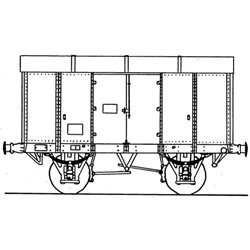Static grass puffer bottles work by manually charging model grass fibres with static electricity. When the charged...
No products
Product successfully added to your shopping cart
There are 0 items in your cart. There is 1 item in your cart.
Search Tips
The Evolution of BR Wagon Classification
Understanding the evolution of wagon classification from diagrams to design codes is a fascinating journey through railway history. Initially, British Railways (BR) relied on diagram numbers to classify different wagon designs. These diagrams were drawings that showcased the general configuration of wagons without delving into intricate details. They were categorised into various books and page numbers, which were essential references for wagon construction. However, with the introduction of the TOPS (Total Operations Processing System) in the 1960s, a new system emerged: design codes.
Design codes replaced diagram numbers as the primary method of categorising wagon configurations. Unlike the diagrams, design codes offered a more detailed classification by allowing for variations within each design. The format of these codes, such as AB001A, provided insights into the wagon's design and any subsequent modifications. This new system proved to be more flexible and comprehensive, accommodating a broader range of wagon types and variations. For you as a model railway builder, understanding these codes can help you recreate models that are historically accurate and intricately detailed.
The transition from diagrams to design codes was not just a matter of convenience; it marked a significant advancement in wagon classification. Diagrams grouped similar wagon types but often struggled to accommodate the increasing diversity of designs. The design code system, on the other hand, allowed for a more nuanced approach. For example, a single TOPS code might cover multiple variants of a wagon, each with its own specific design code. This detailed classification is invaluable for enthusiasts seeking to accurately replicate specific wagons in their scale models.
One intriguing aspect of design codes is their adaptability to significant changes in wagon designs. For instance, the BA001A design code covered the first-built BAA wagons, while subsequent variants like BA001B and BA001C reflected specific modifications. This level of detail ensures that you can track the evolution of a wagon's design, making it easier to choose the correct model for your railway setup. Whether you're building a layout that focuses on early 20th-century railways or modern freight trains, design codes provide the detailed information needed for accurate replication.
In conclusion, the evolution from diagrams to design codes revolutionised the way wagons were classified and understood. This transition offers scale model railway enthusiasts like yourself the opportunity to delve deeper into the intricacies of wagon designs, enhancing the accuracy and historical fidelity of your models. By understanding both diagrams and design codes, you can ensure that your model railway projects are both detailed and authentic, reflecting the rich history of British Railways.
Click here to receive the tips weekly in your mailbox. You can unsubscribe at any time.










